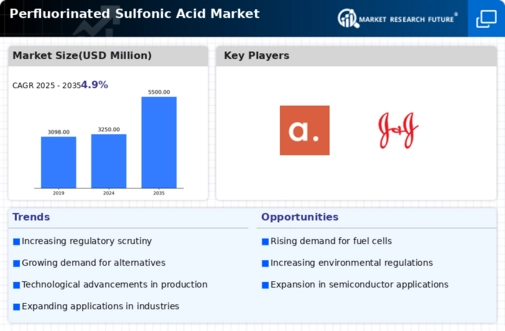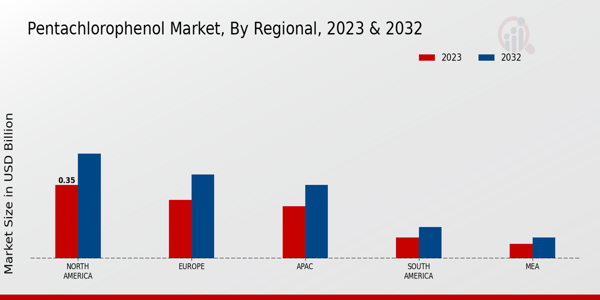Market Trends and Forecasts
The Global Perfluorinated Sulfonic Acid Market Industry is characterized by evolving trends and forecasts that indicate a robust growth trajectory. With a projected market size of 3250 USD Million in 2024 and an expected increase to 5500 USD Million by 2035, the industry is poised for significant expansion. The compound annual growth rate of 4.9% from 2025 to 2035 suggests a steady increase in demand driven by various factors, including technological advancements and regulatory support. As industries continue to innovate and seek sustainable solutions, the market for perfluorinated sulfonic acids is likely to flourish, reflecting broader trends in environmental consciousness and energy efficiency.
Rising Demand in Electronics
The Global Perfluorinated Sulfonic Acid Market Industry experiences a surge in demand driven by the electronics sector. Perfluorinated sulfonic acids are integral in the production of ion-exchange membranes used in fuel cells and batteries. As the global push for cleaner energy solutions intensifies, the need for efficient energy storage systems becomes paramount. In 2024, the market is projected to reach 3250 USD Million, reflecting the growing reliance on these materials in advanced electronic applications. This trend is expected to continue, with the market potentially expanding as industries seek sustainable alternatives, thereby enhancing the overall growth trajectory of the Global Perfluorinated Sulfonic Acid Market Industry.
Advancements in Fuel Cell Technology
Innovations in fuel cell technology significantly influence the Global Perfluorinated Sulfonic Acid Market Industry. As fuel cells gain traction as a clean energy source, the demand for perfluorinated sulfonic acids, which serve as critical components in proton exchange membranes, is likely to increase. The automotive sector, in particular, is investing heavily in hydrogen fuel cell vehicles, which utilize these membranes for efficient energy conversion. This growing interest is anticipated to propel the market forward, with projections indicating a market size of 5500 USD Million by 2035. Such advancements not only enhance performance but also contribute to the sustainability goals of various industries, thereby driving the Global Perfluorinated Sulfonic Acid Market Industry.
Emerging Markets and Economic Growth
Emerging markets play a pivotal role in the expansion of the Global Perfluorinated Sulfonic Acid Market Industry. As economies in regions such as Asia-Pacific and Latin America continue to grow, the demand for advanced materials, including perfluorinated sulfonic acids, is expected to increase. These regions are witnessing a surge in industrial activities, particularly in sectors such as automotive and electronics, which rely heavily on these compounds for their operations. The anticipated growth trajectory suggests that the market will benefit from increased investments and infrastructure development in these emerging economies, further solidifying the position of perfluorinated sulfonic acids within the global market landscape.
Regulatory Support for Green Technologies
The Global Perfluorinated Sulfonic Acid Market Industry benefits from increasing regulatory support aimed at promoting green technologies. Governments worldwide are implementing stringent regulations to reduce carbon emissions and encourage the adoption of renewable energy sources. This regulatory landscape fosters an environment conducive to the growth of perfluorinated sulfonic acids, which are essential for the development of efficient energy systems. As a result, manufacturers are likely to invest in these materials to comply with environmental standards. The anticipated compound annual growth rate of 4.9% from 2025 to 2035 underscores the potential for expansion within the market, driven by favorable policies and incentives that support sustainable practices in various sectors.
Growing Applications in Chemical Processing
The Global Perfluorinated Sulfonic Acid Market Industry is witnessing an expansion in applications within the chemical processing sector. These compounds are utilized as catalysts and surfactants in various chemical reactions, enhancing efficiency and product yield. The versatility of perfluorinated sulfonic acids makes them suitable for a range of industrial applications, including pharmaceuticals and agrochemicals. As industries seek to optimize processes and improve product quality, the demand for these materials is likely to rise. This trend is expected to contribute to the overall growth of the market, as companies increasingly recognize the benefits of incorporating perfluorinated sulfonic acids into their production methodologies.














Leave a Comment